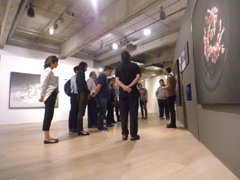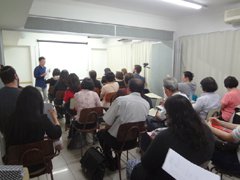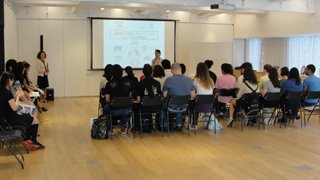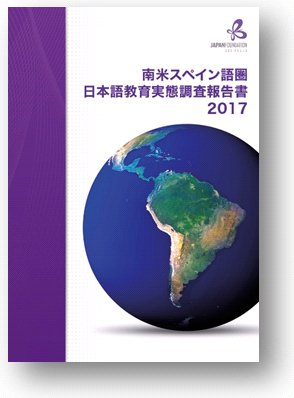Three Years Since Providing Wider Support for a Wider Range of Learners
The Japan Foundation, Sao Paulo
KUNO Gen, NAKAJIMA Eriko, NOMURA Yumiko, YOSHIOKA Chisato
Future Aspirations (KUNO Gen)
There are four Japanese-Language Specialists dispatched to The Japan Foundation, Sao Paulo (hereinafter “FJSP”). I only arrived just one month ago to replace my predecessor (and I am writing this article in April), so I would like to write about my aspirations.
One of my responsibilities is teacher training. For the training hosted by FJSP, we are allowed to decide on course content based on the needs of the participants. But for off-site courses we are requested to carry out, we have to carry out the lectures and workshops according to the themes and time frames specified by the training host (institution) without gaining an adequate understanding of the problems faced by the participants beforehand. Accordingly, my hope is that, with the permission of the training hosts, we will be able to get involved in the training from the planning stage.
The next and later sections of this article consist of the reports from the three Japanese-Language Specialists for whom this year will be the last year in their terms of dispatch. Each report describes the results of the support they provided during their term. I also intend to consider the best way to provide support, and put that into practice, so that I too may submit a positive report at the end of my own dispatch.
Collaboration With a Variety of Institutions (NAKAJIMA Eriko)
As the world’s largest ethnic Japanese community outside Japan, São Paulo is home to numerous Japanese language schools and related institutions. Accordingly, we work with a variety of institutions to support Japanese-language education.
Japan House–Supporting Learners

The Japan House was opened in São Paulo in April 2017 as a place to communicate the diverse appeals of Japan. Since then, we have been hosting a cultural Japanese-language course there with the help of the Japan House. In the fall of 2017, I visited the “Satoyama Exhibit” held at the Japan House with students of the Japanese-language course, during which the students were guided through the exhibit by the curator. Afterwards, we held a discussion session. The students were able to experience a piece of culture based on a different set of values than Brazil through the exhibit which focused on Japan’s unique food culture of artistically presenting the simplest of foods and enhance their understanding of their own and other cultures.
Cultural Alliance Brazil-Japan – Teacher Support

The Cultural Alliance Brazil-Japan, a language learning institution in São Paulo, has over 1,500 students learning Japanese. The institution adopted the teaching material “Marugoto: Japanese Language and Culture” (hereinafter “Marugoto”) in 2015, and teacher training is held once every six months before the start of each new semester. The training was led in AY2017 by five teachers with the longest experience in teaching Marugoto, and the teacher training enabled teachers to learn together while sharing their knowledge and experience. We hope to continue this type of cyclical training program moving forward.
Support for Higher Educational Institutions–Training Student Tutors for “Languages without Borders” (NOMURA Yumiko)
“Languages without Borders” (Idiomas sem Fronteiras, in Portuguese) program of Ministry Education of Brazil (Ministério da Educação), currently offers Japanese- language courses at five federal universities: University of Brasilia, Federal University of Rio de Janeiro, Federal University of Paraná, Federal University of Rio Grande do Sul, and Federal University of Amazonas, as well as one state university, Paulista State University, Assis Campus. The course was originally designed for science and engineering students who wished to study in Japan, but it currently has expanded to encompass all majors without restriction for the purpose of “enriching language education within higher education in Brazil.” The course at each university is run by a student majoring in Japanese, known as a “Student Tutor.” Though they are students, they still stand at the front of the classroom in the role of teacher, so FJSP is putting effort into supporting the training of these Student Tutors. In February 2018, 22 Student Tutors were invited to São Paulo to participate in the “Languages Without Borders - Workshop for Student Tutors in São Paulo.” This training brought various levels of Student Tutor to work together, including those who had already led classes for four semesters since 2016, those who led their first class in 2017, and those scheduled to begin the role for the first time from the first half of 2018, enabling the Student Tutors to share information and achieve results by learning together. Among the students were those for whom this would be their last training with graduation approaching, after which they would lead classes as actual teachers at Japanese language schools and other educational institutions, and this fact of their development as Student Tutors demonstrated the great importance of the training for the development of Japanese-language education in Brazil moving forward.

The opening ceremony for the training
The 22 Student Tutors from 5 federal and 1 state universities who participated in the Languages without Borders Japanese course.
Activities of the South American Japanese-Language Advisors (YOSHIOKA Chisato)
The activities of the South American Japanese-Language Advisors were launched in 2015. The culmination of that first phase (the research phase), was completed in 2017: “The Survey on Japanese-Language Education in Spanish Speaking South America 2017.”http://fjsp.org.br/lingua-japonesa/pesquisa-de-dados/#nambei2017

During the research tour of 2016, we visited 10 regions in nine countries with the cooperation of nearly 140 people from 40 institutions. In addition to the research, we also received reviews and feedback from persons involved in Japanese-language education in each country during the preparation of this report as well. In other words, the final report itself made possible through the support of everyone involved in Japanese-language education throughout Spanish speaking South America.
The report is mainly divided into two sections, the first of which gives an overview of Japanese-language education in the nine countries in Spanish speaking South America. The second section goes on to list the situation in each country and their respective action plans. These “action plans” set the report apart for other typical reports. The action plans cover a five year period from April 2017 through March 2022. This leaves four years remaining now that one year has already passed. We intend to continue putting all of our effort into moving the plans steadily forward together with the persons involved in Japanese-language education in each country in order to further invigorate Japanese-language education in Spanish speaking South America.
- What We Do Top
- Arts and Cultural Exchange [Culture]
- Japanese-Language Education Overseas [Language]
- Japanese-Language Education Overseas [Language] Top
- Learn Japanese-language
- Teach Japanese-language
- Take Japanese-Language Test
- Know about Japanese-language education abroad
- The Japanese-Language Institute, Urawa
- The Japanese-Language Institute, Kansai
- Japanese-Language Programs for Foreign Specified Skilled Worker Candidates
- Japanese Language Education for Japanese Children Resident Overseas and for the Descendants of Migrants
- Archives
- Japanese Studies and Global Partnerships [Dialogue]
- JF digital collection
- Other Programs / Programs to Commemorate Exchange Year
- Awards and Prizes
- Publications
